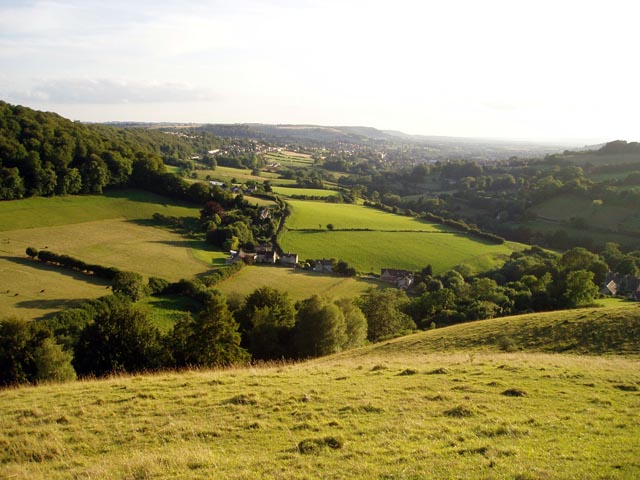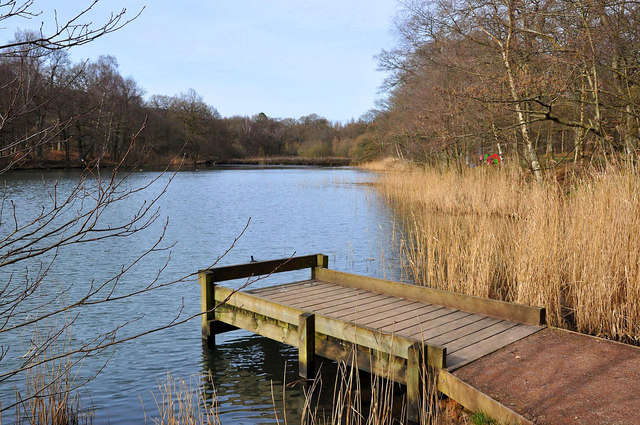|
Gloucestershire Wildlife Trust
The Gloucestershire Wildlife Trust is the Gloucestershire local partner in a conservation network of 46 Wildlife Trusts. The Wildlife Trusts are local charities with the specific aim of protecting the United Kingdom's natural heritage. The Gloucestershire Wildlife Trust is managed by a Board of Trustees elected from its membership who provide overall direction for the development of the trust and there are advisory committees. The work of the trust is carried out through staff and volunteers. History The trust was founded in 1961 and was then named the Gloucestershire Trust for Nature Conservation. Founder members included Sir Peter Scott, Christopher Cadbury and a group of other local people with the shared interest of nature conservation. The name was changed to the Gloucestershire Wildlife Trust in 1991. In 1990 Lady Scott became the trust's patron succeeding her late husband, Sir Peter Scott. Originally the trust headquarters was at Church House, Standish, which was opene ... [...More Info...] [...Related Items...] OR: [Wikipedia] [Google] [Baidu] |
Robinswood Hill
Robinswood Hill () is a hill and country park to the south of the city centre of Gloucester, close to the Stroud Road (A4173). It rises to 650 ft (198 m), and is owned and managed by Gloucester City Council's Countryside Unit. The Gloucestershire Wildlife Trust also has its head office based here. It was originally one of the main sources of water to the city. The springs rising on Robin's Wood Hill were used by Gloucester Abbey in the 13th century. Reservoirs were built by the Gloucester Water Company in 1837-8 and taken over by the City in 1855. Robinswood Hill ceased to provide water supply in 1924 but the reservoirs remained in use for storage until 1946; they have now been backfilled to provide car parks and a countryside centre for the thousands of visitors that use the hill for recreation and inspiration. It is home to several species of wildlife, and has views of the surrounding area - including other hills of Gloucester, the Cotswolds, Malvern Hills, May Hill a ... [...More Info...] [...Related Items...] OR: [Wikipedia] [Google] [Baidu] |
Greystone Farm Nature Reserve - Geograph
Greystone or Graystone may refer to: Locations *Graystone Manor, the first condominium building built in the continental United States * Greystone, West Virginia * Greystone Airport, a private airport in Ocala, Florida * Greystone (estate), a historical estate and gardens near New York City * Greystone Mansion, Beverly Hills, California mansion built by/for Edward L. Doheny, listed on the NRHP as ''Doheny Estate/Greystone'' * Greystone (Harrodsburg, Kentucky), listed on the NRHP in Mercer County, Kentucky * Greystone Castle, Reno, Nevada * Greystone (Durham, North Carolina) * Greystone Historic District, North Providence, Rhode Island * Greystone Mill Historic District, North Providence, Rhode Island * Greystone Cellars, St. Helena, California, NRHP-listed, in Napa County * Greystone Villa-Cabin 18, Cleveland National Forest, California * Gustave Greystone-Meissner House, Pevely, Missouri * Greystone Golf & Country Club, a private golf course in Birmingham, Alabama * Gre ... [...More Info...] [...Related Items...] OR: [Wikipedia] [Google] [Baidu] |
Chedworth Nature Reserve
Chedworth Nature Reserve () is a nature reserve in Gloucestershire.Kelham, A, Sanderson, J, Doe, J, Edgeley-Smith, M, et al., 1979, 1990, 2002 editions, 'Nature Reserves of the Gloucestershire Trust for Nature Conservation/Gloucestershire Wildlife Trust' The site is listed in the 'Cotswold District' Local Plan 2001-2011 as a Key Wildlife Site (KWS).Cotswold District Local Plan, Appendix 2, Key Wildlife Sites The Chedworth Nature Reserve is owned and managed by the and was purchased in 1969. It was one of the earliest acquisitions of the t ... [...More Info...] [...Related Items...] OR: [Wikipedia] [Google] [Baidu] |
Chaceley Meadow SSSI
Chaceley Meadow () is a biological Site of Special Scientific Interest in Gloucestershire, notified in 1954 and renotified in 1993. It lies on the eastern edge of Chaceley village and is about half a mile west of the River Severn. The site is listed in the ‘Tewkesbury Borough Local Plan to 2011’, adopted March 2006, Appendix 3 'Nature Conservation',' as a Key Wildlife Site (KWS). The site is owned (bought in 1994) and managed by the Gloucestershire Wildlife Trust. It is one of the county's finest unimproved wet meadows. Though it is some distance from the River Severn the meadow may flood in winter.Kelham, A, Sanderson, J, Doe, J, Edgeley-Smith, M, et al, 1979, 1990, 2002 editions, 'Nature Reserves of the Gloucestershire Trust for Nature Conservation/Gloucestershire Wildlife Trust' Plants A colourful variety of flowers may be seen throughout spring and summer. These include cuckoo flower, marsh-marigold, great burnet, meadowsweet, common knapweed, meadow vetchling, mars ... [...More Info...] [...Related Items...] OR: [Wikipedia] [Google] [Baidu] |
Cannop Ponds
Cannop Ponds () are two large ponds, just north of Parkend in the Forest of Dean, Gloucestershire, England. The ponds, and surrounding area, are a popular tourist destination. An area of reeds above the top pond, known as 'Cannop Bridge Marsh', is a nature reserve managed (under agreement since 1983) by the Gloucestershire Wildlife Trust. The site (Cannop Bridge Marsh and Cannop Ponds & Woods) are listed in the 'Forest of Dean Local Plan Review' as a Key Wildlife Site (KWS). History The lower pond was created in 1825 to supply water, via a leat, to a waterwheel at Parkend Ironworks. The flow of water proved unreliable and an upper pond was added in 1829 to boost the supply. Facilities Facilities at the ponds include a large car park, information boards, picnic tables and a waymarked walk. The ponds also feature on the Forest of Dean Family Cycle Trail. The ponds are used for fishing by the Yorkley Angling Club, from 1 May to 31 March each year. Wildlife The ponds are a w ... [...More Info...] [...Related Items...] OR: [Wikipedia] [Google] [Baidu] |
Cotswold Water Park
The Cotswold Water Park is the United Kingdom's largest marl lake system, straddling the Wiltshire–Gloucestershire border, northwest of Cricklade and south of Cirencester. There are 180 lakes, spread over . The park is a mix of nature conservation activities, including nature reserves; recreation, including sailing, fishing, a country park and beach with water sports and play areas; rural villages; and holiday accommodation. It is a significant area for wildlife and particularly for wintering and breeding birds. The local wildlife trusts (Gloucestershire and Wiltshire) are involved in partnership with the Cotswold Lakes Trust charity in working with local communities and organisations in the area. Origins The lakes were created in the second half of the 20th century by extraction of glacial Jurassic limestone gravel, which had eroded from the Cotswold Hills, and these filled naturally from rivers and streams after workings began to be exhausted in the early 1970s.Kelham ... [...More Info...] [...Related Items...] OR: [Wikipedia] [Google] [Baidu] |
Brassey SSSI
Brassey () is a biological Site of Special Scientific Interest in Gloucestershire, notified in 1954 and renotified in 1983. It is situated on the north side of the Windrush Valley, midway between Naunton and Upper Slaughter. The reserve comprises sloping, unimproved limestone pasture. There is a fast-flowing stream. This site is one of the few freshwater marshes in Gloucestershire.Kelham, A, Sanderson, J, Doe, J, Edgeley-Smith, M, et al, 1979, 1990, 2002 editions, 'Nature Reserves of the Gloucestershire Trust for Nature Conservation/Gloucestershire Wildlife Trust' The stream joins the River Windrush. The site is in the Cotswolds Area of Outstanding Natural Beauty. The site is listed in the 'Cotswold District' Local Plan 2001–2011 (on line) as a Key Wildlife Site (KWS). [...More Info...] [...Related Items...] OR: [Wikipedia] [Google] [Baidu] |
Dymock Woods SSSI
Dymock Woods (, , ) is a biological Site of Special Scientific Interest in Gloucestershire, notified in 1990. The site is listed in the 'Forest of Dean Local Plan Review' as a Key Wildlife Site (KWS). The site is divided into three units of assessment and includes the Gloucestershire Wildlife Trust nature reserve known as Betty Daw's Wood which is unit 3.Kelham, A, Sanderson, J, Doe, J, Edgeley-Smith, M, et al, 1979, 1990, 2002 editions, 'Nature Reserves of the Gloucestershire Trust for Nature Conservation/Gloucestershire Wildlife Trust' Dymock Woods Site The Dymock Woods site (comprises Dymock Wood, Daw's coppice, Betty Daw's Wood and Colonel's Grove) is a few miles south-west of Dymock which is in north-west Gloucestershire. The site has the best areas of mature sessile oak which remain in Dymock Forest. These sessile oak plantations have developed a high forest structure. Dymock Forest is important for invertebrates such as moths and butterflies. The woods are on draini ... [...More Info...] [...Related Items...] OR: [Wikipedia] [Google] [Baidu] |
Lower Wye Gorge SSSI
Lower Wye Gorge (, ) is a biological and geological Site of Special Scientific Interest in Gloucestershire, notified in 1954 and renotified 1987. The site includes two Gloucestershire Wildlife Trust nature reserves being Ban-y-gor Wood and Lancaut. The Natural England citation states a revision for Lancaut inclusion. The site (Lancaut and Ban-y-gor) is listed in the 'Forest of Dean Local Plan Review' as a Key Wildlife Site (KWS). Wye Valley Woodlands/ Coetiroedd Dyffryn Gwy are recognised as a Special Area of Conservation (SAC) under the EU Habitats Directive. Location and habitat The Lower Wye valley Gorge is in the Wye Valley Area of Outstanding Natural Beauty. The woodlands of the lower Wye Valley are one of the most important areas for woodland conservation in the United Kingdom. This is an area of semi-natural woodland which is continuous along the gorge sides. The woods are a mixture of stand types which are considered to be similar to the original natural woods of th ... [...More Info...] [...Related Items...] OR: [Wikipedia] [Google] [Baidu] |
Ashleworth Ham
Ashleworth Ham () is a biological Site of Special Scientific Interest. It is a large area of grassland on the Severn floodplain, north of Ashleworth in Gloucestershire, England. It is registered as a Site of Special Scientific Interest and was notified in 1974 and renotified in 1985. Ashleworth Ham received this designation because it is one of three sites in the Severn Vale where migratory waterfowl winter. The site has three units of assessment and is part managed as a nature reserve by the Gloucestershire Wildlife Trust. The nature reserve is unit 1 () and is a area. Unit 2 () is a site and unit 3 () is a site, and are areas to the east of the nature reserve. The site is fen, marsh, swamp lowland, open water ditches, neutral grassland and hedges divide many of the fields. Access to the reserve is prohibited in winter, but the birds may be viewed from hides in Meerend Thicket. The Thicket is a steep wooded bank and indicates the former much higher boundary of the Sever ... [...More Info...] [...Related Items...] OR: [Wikipedia] [Google] [Baidu] |
Arle Grove
Arle Grove () is a nature reserve in Gloucestershire. The site is listed in the 'Cotswold District' Local Plan 2001-2011 as a Key Wildlife Site (KWS). The site is owned and managed by the . It was donated to the Trust as a nature reserve in 2009. Location and habitat The reserve is an example of which supports a wide range of species. It is about 500 m to the north of |




